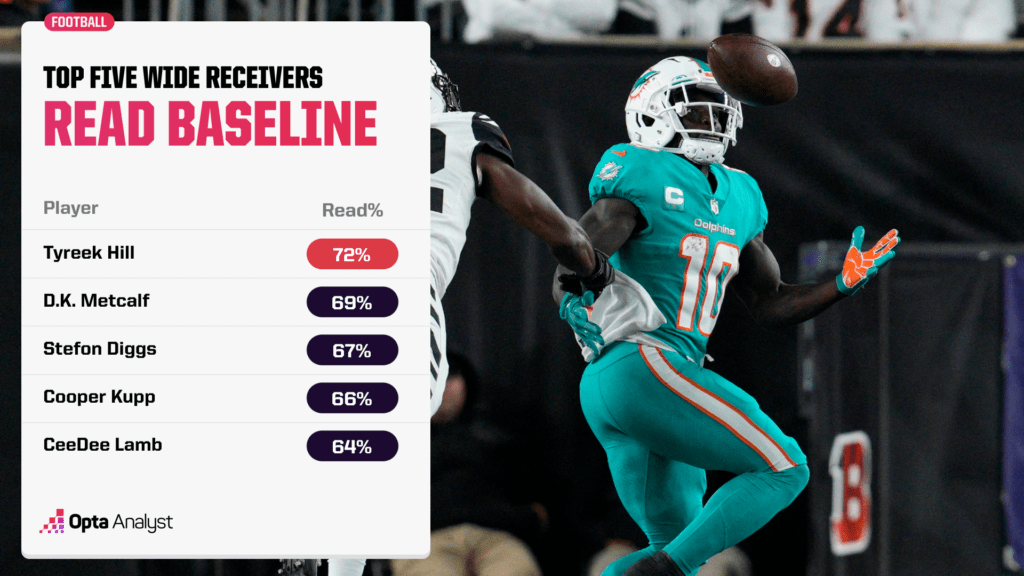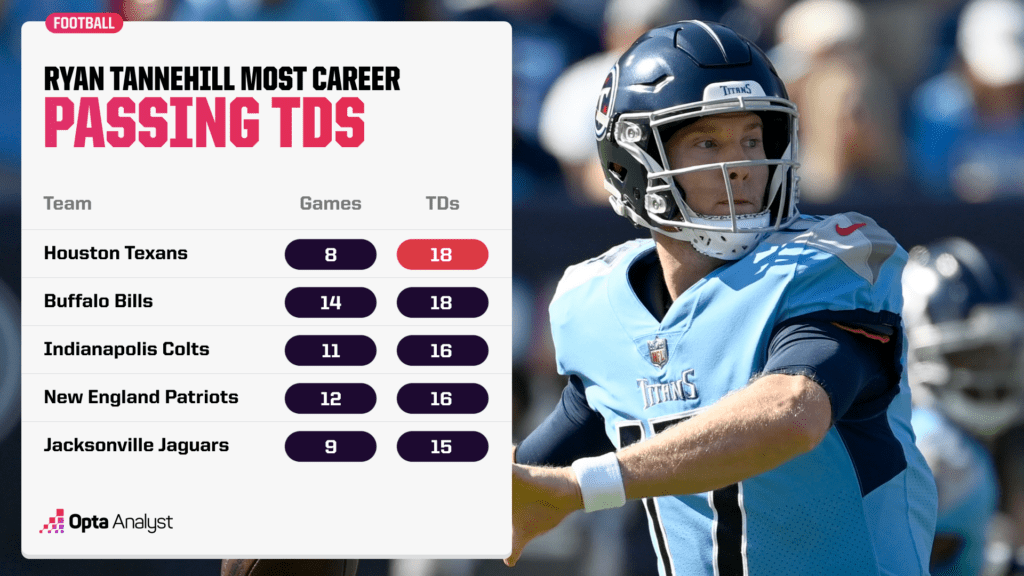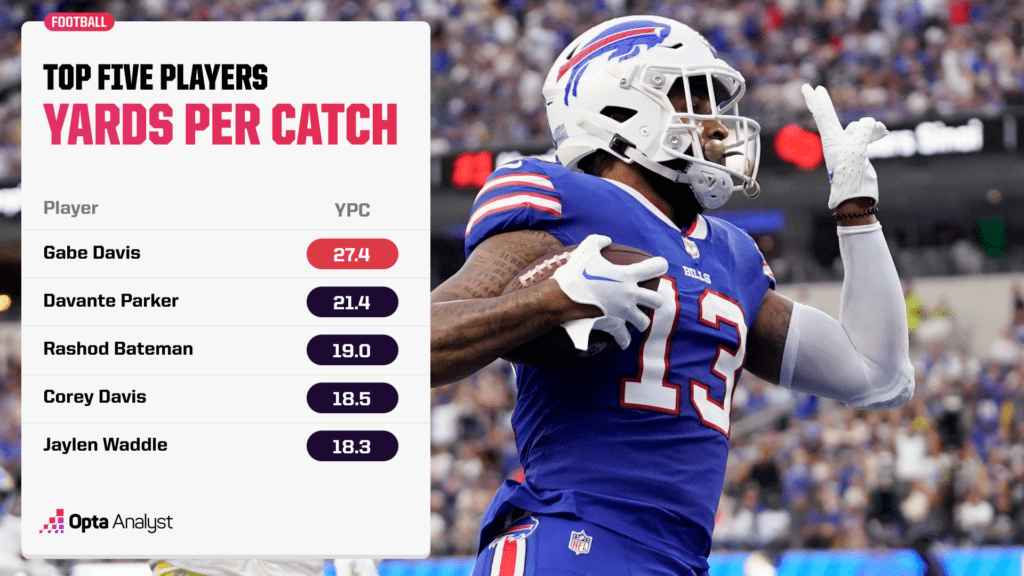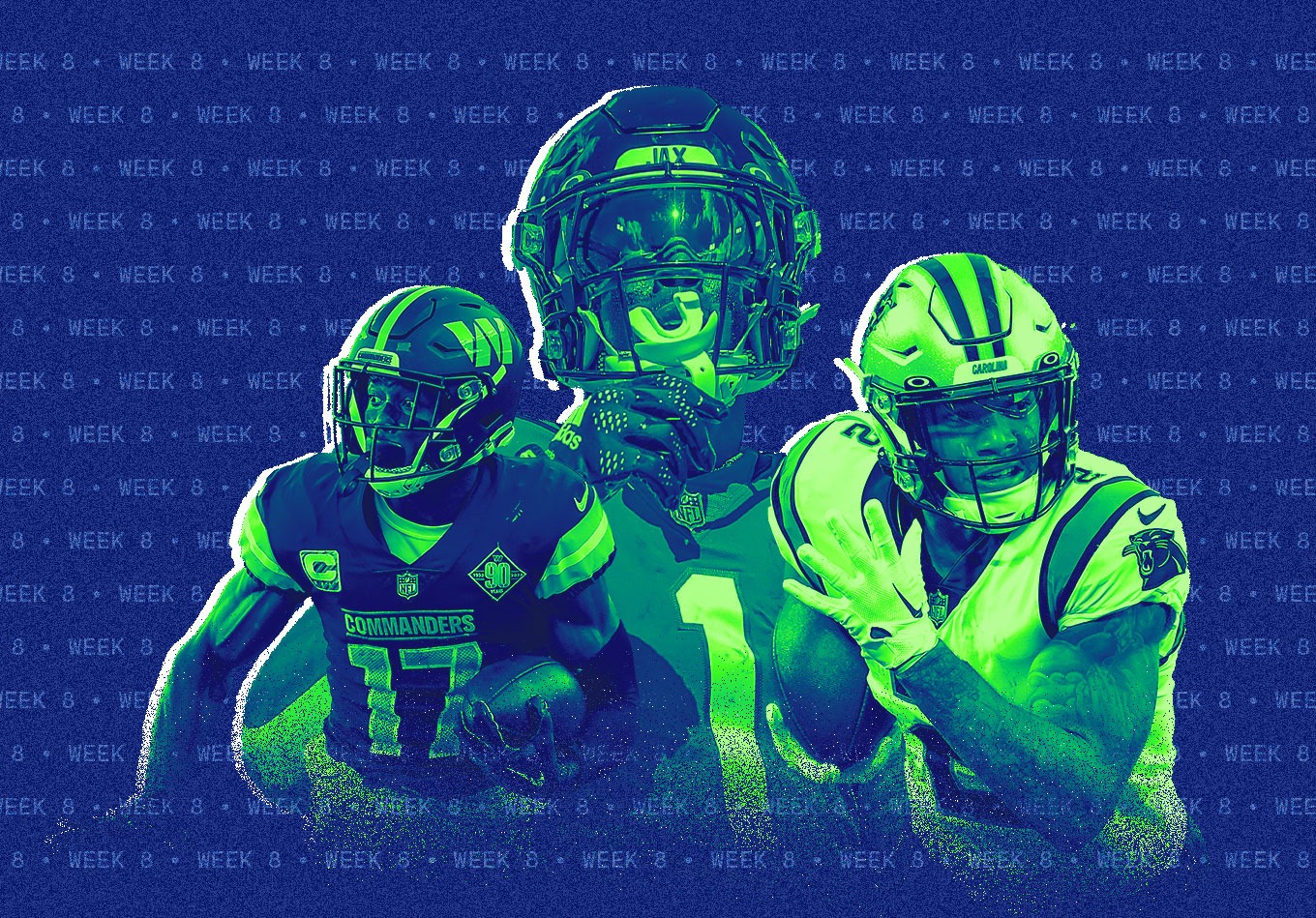Fantasy Football Quick Hits
- Week 8 Yays: Ryan Tannehill (QB13), Travis Etienne (RB5), Devin Singletary (RB9), Adam Thielen (WR11), Terry McLaurin (WR13), DJ Moore (WR14)
- Week 8 Nays: Dak Prescott (QB16), Joe Mixon (RB18), Amon-Ra St. Brown (WR27), Gabriel Davis (WR37)
- Key Data Point: Travis Etienne ranks third among all running backs in yards per carry (6.10), including averaging over seven yards per carry in his last three games. He’s also in the top 20 in yards before contact (3.26) and yards after contact (2.31).
Let’s chat about two players that are both significant Yays this week, two players that our loyal readers will be shocked to find out we’re calling Yays.
Terry McLaurin and DJ Moore.
Since the beginning of last season, our model has consistently found these two to be the most overrated by the industry. Just last week, for example, McLaurin and Moore ranked as WR45 and WR26, respectively. In Week 6, Moore was WR36. And back in Week 4, McLaurin was our WR56 (!!!).
So how do both find themselves as darlings of our projections? Allow us to explain.
A good model is constantly learning. But so are we. In fact, among all experts that submit rankings in Fantasy Pros, our running back rankings are the most accurate. We’ve also had a No. 1 finish and a couple of top-10 showings overall.
But something in our model that is producing brilliant rankings for running backs isn’t working quite as well for wide receivers. So, we have made a couple tweaks to expand our data and see if we can’t bring our wide receiver rankings up to the highest standard that we hold ourselves.
What we’ve done is introduced an internal baseline, called a “read baseline”, which measures how often an eligible receiver is “read” by the quarterback. Essentially, when a player is running a route, is the quarterback paying them any attention?
This serves multiple purposes, but the most useful is that it eliminates our reliance on target share as one of the major weights in producing our wide receiver rankings each week. The thing about targets is that just because players were recipients of targets doesn’t mean they were supposed to have been. In fact, there are tons of plays throughout every game in which a receiver who wasn’t part of the primary play design ultimately receives the target.
Last week’s Baltimore Ravens game is a good example. Star tight end Mark Andrews had his worst game in years. He didn’t have a catch and only had two targets. But he was on the field for 19 passing snaps, and of those 19, he was “read” by Lamar Jackson 12 times – a 63% clip. Meaning that while he saw very little involvement in terms of targets and receptions, he was still a critical piece of the Ravens offense.
There are, on average, just under two reads per play. Most plays have two reads, but screens and hot routes have only one and longer developing concepts can have three or sometimes even four. Therefore, when compared with just using targets, we are doubling our sample size.
But more than that, NOT being read is also important, as it means you are a checkdown option (usually running backs). So against teams with excellent defenses, targets for read receivers would go down and checkdown receivers would go up because those excellent defenses are more likely to force the quarterback to throw the ball somewhere unplanned.
So to summarize, we’re now recording whether a QB looks at an eligible receiver and that is producing a “read baseline” that is replacing our previously used target baseline because this level of data allows us to know how often a player is potentially being given the chance to make a play.
We were previously declaring an opportunity as a target, but now we’re hopping one step above that to say that a target comes from being a “read” by the QB. This is crucial, because there’s an almost exact ratio of one target for every two reads.
Bringing this back to McLaurin and Moore, why does this switch so positively impact their outlook?
The average wide receiver is “read” on 41% of passing snaps. Tyreek Hill leads the position at 72%.

McLaurin is a part of the read on 62% of his passing snaps for the Washington Commanders. Moore has a 52 read percentage for the Carolina Panthers. Those are both elite numbers and over time, our model expects both to have performances more in line with their “read baseline” or read percentage.
As always, let’s jump around and evaluate some Week 8 projections gathered from some of the top data-driven projections available using several of our AI-powered models. Refer back to our fantasy football rankings for any questionable waiver wire or lineup decisions.
Week 8 Yays
Note: We’re comparing our rankings to the expert consensus rankings (ECR) from FantasyPros. These rankings update throughout the week (We pulled these numbers from Thursday.). Once again, we are using PPR unless noted otherwise.
Ryan Tannehill, QB (TEN) vs. HOU (ECR: 21, Our Rank: 13, Projected Points: 15.76)
It’s been a slow start for the Tennessee Titans passing offense. Tannehill has only surpassed 200 yards once since Week 1 and he’s only thrown six touchdown passes in six games.
Nothing like a game against the Houston Texans to turn things around for Tannehill. His 18 passing touchdowns against the Texans are his most versus any opponent.

In his last four meetings with the Texans, Tannehill has averaged just under 300 passing yards while totaling 10 passing touchdowns. In a week with quarterback stalwarts on the Kansas City Chiefs and Los Angeles Chargers on bye, Tannehill is a more than serviceable option to step into your lineups.
He’s in the same class of quarterback as the Denver Broncos’ Russell Wilson, Seattle Seahawks’ Geno Smith and Las Vegas Raiders’ Derek Carr in that they all can produce QB1 numbers if things break their way.
Travis Etienne, RB (JAX) vs. DEN (ECR: 11, Our Rank: 5, PP: 18.00)
Let’s be clear, Etienne was already well on his way to winning the main role in Jacksonville’s backfield. And then the Jaguars traded James Robinson to the New York Jets and now Etienne’s role is cemented as the clear RB1 in the offense.
And for fantasy managers, they’ll be rejoicing for the rest of the season. Etienne ranks third among all running backs in yards per carry (6.10), including averaging over seven yards per carry in his last three games. Etienne is also in the top 20 in yards before contact (3.26) and yards after contact (2.31).
Now with the backfield to himself, look for his volume to skyrocket. That’s certainly what our model is expecting. The industry is still apprehensive, ranking him as a solid RB2. But our algorithms have no such qualms. He’s a set-and-forget RB1.
Devin Singletary, RB (BUF) vs. GB (ECR: 22, Our Rank: 9, PP: 16.48)
Back in the preseason, we had Singletary as a season long Nay for one critical reason. We said: “If you know that Singletary is going to be the lead back on the Bills, draft him!”
However, between Zack Moss and rookie James Cook, plus Josh Allen’s rushing ability and volume, our model was skeptical that Singletary would receive enough volume to live up to his ADP as RB28. Well, Singletary has more carries than the rest of the Buffalo running backs combined and is also second on the team in receptions.
In fact, the only thing holding Singletary back is a lack of touchdowns, with only one (receiving) so far. But with at least four receptions in three of his last four games, Singletary is receiving valuable volume on the league’s second-highest scoring team. Coming off a bye and playing a reeling Green Bay Packers squad that just allowed 167 scrimmage yards to Washington running backs, Singletary is in position to take advantage.
He’s a low-end RB1 this week.
Adam Thielen, WR (MIN) vs. ARI (ECR: 30, Our Rank: 11, PP: 15.49)
Thielen’s ability to score touchdowns has him consistently higher in our model’s projections than industry consensus.
It’s the combination of Thielen’s scoring ability and his floor as the clear No. 2 option in the Minnesota Vikings’ passing hierarchy that makes him a consistently strong play. He’s received at least seven targets in each of his last five games and is now facing an Arizona Cardinals defense that is in the bottom 10 in the NFL in passing yards allowed per game, yards per attempt and passing touchdowns allowed.
Only five wide receivers are more likely to score this week than Thielen, per our model. And Justin Jefferson is our highest projected wide receiver. But with just enough offense on the other sideline in Kyler Murray and DeAndre Hopkins – the Cardinals just scored 42 points on the New Orleans Saints last week – Kirk Cousins is going to need to have success through the air and Thielen will be a key recipient.
He’s a sleeper candidate to produce WR1 numbers this week.
Terry McLaurin, WR (WSH) vs. IND (ECR: 27, Our Rank: 13, PP: 14.82) and DJ Moore, WR (CAR) vs. ATL (ECR: 25, Our Rank: 14, PP: 14.57)
The unique thing about the aforementioned change we’ve made is that while both players have previously had productive seasons, neither is particularly having a great season. McLaurin enters the week as WR25. Moore as WR40. Both are also dealing with new quarterbacks.
But these two are must-start options this week. Our model is highlighting their talent, importance and relevance within their respective offenses as to why. We’re starting them with confidence. So should you.
Week 8 Nays
Dak Prescott, QB (DAL) vs. CHI (ECR: 8, Our Rank: 16, PP: 14.72)
Did you know that last week was the first time all season that the Dallas Cowboys scored three touchdowns in a game? Did you know that they only have one game this year with more than one passing touchdown and that Prescott, in his two full games, only has one total touchdown?
Meanwhile, did you know that the Chicago Bears have only allowed five passing touchdowns all season? The Bears enter this game with sky high confidence after dismantling the New England Patriots and their quarterback duo of Mac Jones and Bailey Zappe to the tune of three interceptions. While the Bears offense might struggle to score, the defense is playing like one of the league’s best units.
In a game that is a good bet to be the lowest scoring contest of the week, our model is skeptical that Prescott will produce anything more than QB2 numbers.
Joe Mixon, RB (CIN) vs. CLE (ECR: 10, Our Rank: 18, PP: 13.85)
An all-Ohio Monday night matchup pits two of the league’s best running backs against one another. But it also features an absolutely red-hot Joe Burrow that has thrown for 781 yards and six touchdowns in his last two games, the majority of which came last week against the Atlanta Falcons.
Mixon, meanwhile, has 103 combined rushing yards over the last two games. His 3.35 yards per carry are third worst in the NFL and despite ranking second in the NFL in offensive touches, Mixon is only averaging 83.9 scrimmage yards per game. That’s the worst number among players in the top 10 in touches per game. For comparison sakes, Christian McCaffrey has recorded 145 more scrimmage yards in 20 fewer touches.
Mixon gets a Cleveland Browns team that just allowed two rushing touchdowns to Gus Edwards and held Lamar Jackson to zero total touchdowns. Mixon is merely an RB2 play this week.
Amon-Ra St. Brown, WR (DET) vs. MIA (ECR: 11, Our Rank: 27, PP: 11.39)
It’s been a frustrating few weeks for St. Brown fantasy managers. Before his injury woes began in Week 4, St. Brown was WR3 through three weeks, surging into the new season after having gained real momentum from the way he finished last season. In 2021, he ended up behind only the Los Angeles Rams’ Cooper Kupp among all receivers in the final six weeks in PPR points.
This week, the Detroit Lions face a Miami Dolphins defense that despite being plagued with injuries in the secondary, has only allowed 214.0 passing yards per game in its last three. The defense has also forced as many interceptions as it has allowed touchdown passes during that stretch.
With injury concerns and a stagnating Lions offense that has only totaled six points in its last two games, St. Brown is a Flex play at best this week.
Gabriel Davis, WR (BUF) vs. GB (ECR: 20, Our Rank: 37, PP: 10.64)
The Jets just hammered the Packers last week, becoming the second straight New York team (along with Daniel Jones and the Giants) to defeat Green Bay. This week, Josh Allen and the Buffalo Bills look to make it a clean New York sweep against Aaron Rodgers and the Pack.
Davis is the epitome of what we don’t want in our lineups. He has not surpassed three receptions in a game since Week 1 – when he had only four – and has twice been held under 40 receiving yards. He doesn’t accumulate enough receptions to cultivate a solid floor, meaning fantasy managers are relying solely on big plays and touchdowns.
But Davis has been producing big plays. He is first, by a mile, in yards per reception, so far in front of the rest of the field and with such a big number that he only needs three catches on average to reach double-digit PPR points.

As a result, Davis is averaging more points per game than Mike Williams, who is currently WR9 on the season. He’s done this with just 14 catches on the season. Davis is among our top 20 wide receivers most likely to score a touchdown this week, but his 3.4 projected receptions are by far the lowest in the group.
Allen is our QB1 this week, headlining a top five that includes Jalen Hurts at QB2, Tua Tagovailoa at QB5 and Tom Brady of the struggling Tampa Bay Buccaneers sitting just on the outside at QB6.
Because of the success we’re projecting for Allen, Davis will be hard to bench. But know that if you play him, his entire performance will be predicated on finding that one massive play.
Data modeling by Kyle Cunningham-Rhoads. Don’t forget to check out our NFL Data Day video and podcast.
